
|   |

|   |
 e-mail: leelakaverivenkat@gmail.com Natya Tarangini's Parampara Festival marks its 27th celebration Photos: Rahul Naag November 3, 2023 It is an achievement for the celebrated Reddy trio of Raja/Radha and Kaushalya, under the banner of their institution Natya Tarangini (officially registered in 1976), to be marking the 27th celebration of what has become their signature festival, Parampara. One recollects, with some amusement, the query asked by a generally cynical critic when the festival was first announced. "In the present scenario where are the Paramparas we are celebrating?" Had the person concerned been in our midst today, one wonders how he would have reacted to how the institution of guru /shishya transmission has undergone changes to accommodate a fast moving world, with a Parampara festival now sponsoring Contemporary Dance and Fusion music with an interaction between the tabla and western drums, with other instruments like the keyboard and electric sitar! But one still speaks of the old ragas, and rhythmic patterns following tisra, chatusra, khanda, misra and sankeerna combinations! As time travels, notions and institutions from the past too undergo changes, and though Pariwar Paramparas do exist, children of traditional music and dance families, often take to other professions. The festival (Oct 6 - 8, 2023) opening with Hampi Vaibhavam was Raja's clever idea. Hampi, the capital of the Kingdom of Vijayanagar (which included at its height the regions of Karnataka, Andhra Pradesh and Tamilnadu) established in 1336 by Harihara and Bukka (surprisingly, said to have belonged to the Yadava pastoral background), was rich in Art, literature as well as architecture and the kingdom lasted till the battle of Tallikota in 1565, when the ruler was defeated. During the time of the famous Krishnadevaraya of the Tuluva dynasty of Vijayanagar Empire who reigned from 1509-1529 A.D, dance enjoyed great patronage. While the historical beginnings of dances in India are much earlier, special patronage could be ascribed to the Vijayanagar era, in enabling the art forms, through centuries, to develop into their present forms in the Southern and Eastern kingdoms of India. Hampi Vaibhavam celebrated this era of art through a joint group salutation by groups presenting Mohiniattam, Bharatanatyam, Odissi and Kuchipudi. As the Mohiniattam dancers, students of Jayaprabha Menon, with their gracefully swaying torsos entered to the Tom tom tadinda tom tom syllables and presented Mukhachalam in Suratti ragam, they made an enchanting group. Retaining the muktaippu as in the initially choreographed version by Jayaprabha's guru, Bharati Shivaji, the rest of the composition was a reworked version by Jayaprabha, for the occasion. And the dancers were really involved. 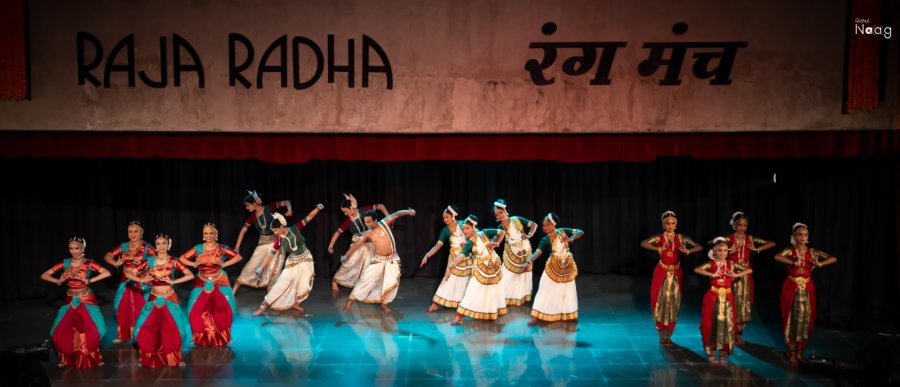 Kuchipudi, Odissi, Mohiniattam & Bharatanatyam ensembles This was followed by the Bharatanatyam group, again unexpectedly comprising Jayaprabha's students. The choice of composition Shankara Sri Giri Natha Prabho in Hamsanandi, with the composer Maharaja Swati Tirunal again pertaining to the region of Kerala (which is the home of Mohiniattam) could not be faulted, for this royal Carnatic music composer's works are very much a part of the Bharatanatyam repertoire. And one had no quarrels with the Shiva emphasis in the dance, dilating on lines like "Bhasma trinetra gale runda mala Pootana ke sanga nache." The performance itself though, while technically equipped, fell short of evoking an intrinsic flavor flowing from that inexplicable cultural memory of dancing bodies - which one could experience in the Mohiniattam presentation. Jayaprabha has been trained in Bharatanatyam, but the dance is not as much part of her persona and art statement as Mohiniattam is. And this shortcoming showed in the presentation. Top of the drawer was the Odissi component comprising students of Sharon Lowen, with three female dancers led by the male dancer Viswanath Mangaraj. The choice of presentation of the Pallavi in Shankarabharanam, choreographed by Sharon's late Guru Kelucharan Mohapatra in 1965, with the accompanying music on tape having the renowned Guru himself reciting the ukkutas and playing the mardal percussion with a melody which only he could produce on the instrument, represented in more ways than one, a part of Odissi history. Besides, Bhubaneswar Misra, the music composer, with his long training under the Carnatic violinist Dwaram Venkataswamy Naidu, showed how Odisha lying at the cusp of two states (Ganjam in Odisha today was part of the earlier Madras Presidency) carried in its musical tradition both the influences of the South and of Odisha. Pallavis in Arabhi, Bilahari, Mukhari, etc testify to the Carnatic influence and the Utkal Sangeet Mahavidyalaya, when inaugurated in 1960's, had a Carnatic music section, which however, over the years, with the advancing influence of Hindustani music, showing a lack of students was terminated. The Odissi dancers were well trained and combined beautifully. And the Kelucharan bani of Odissi came out strongly. It was really a nostalgic experience for those in the audience, like this critic, who had had the good fortune of experiencing Odissi programmes of the sixties, led by Guruji's percussion. The finale in Kuchipudi, as part of Telugu culture, could claim close Hampi connection. Set in its favourite raga of Mohanam, the description of Krishna, in Krishna Sabdam, peaking with the "kalabha sundaragamana kastoori shobhita..." Tarangam conclusion was by students of the Reddys. Without the Reddy daughters and recognisable faces of disciples participating in all their past productions, this was a new lot of students. The four dance forms coming together in the concluding part made for an eye catching end. 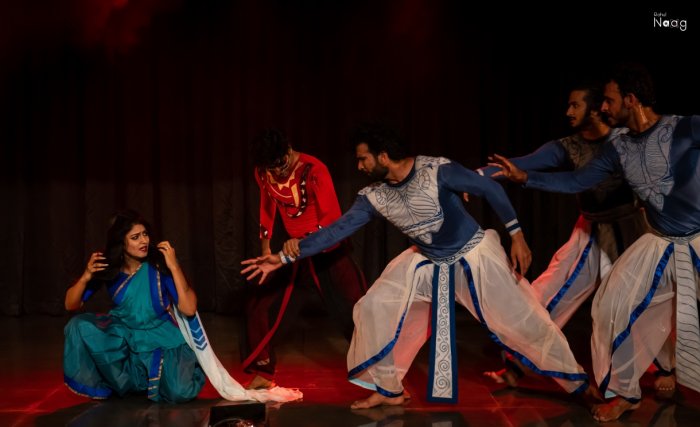 Sadhya group It was Contemporary dance that graced the stage the next evening with Sadhya's presentation of Game of Dice, designed and choreographed by dancer Santosh Nair. Not by any means a new production having been composed in 2004, this particular work has travelled round the world. The group presentation revolves round the Kaurava/Pandava rivalry, with a vengeful Draupadi, abused in the Kaurava court with an abhorrent disrobing attempt, living up to her oath of tying up her loose tresses only after Bhima's anointing of her hair with the blood of the slain Dushasana. The powerful dance language of dice play underlines Santosh Nair's individualistic approach to Contemporary dance evolving from a combination of training in Kathakali (Santosh began his career in 1986, in this form trained by his father Kalamandalam Padmanabhan), Mayurbhanj Chhau of which he was one of the most acclaimed performers in his early 20's, and Contemporary dance for which he was trained under Narendra Sharma. In Game of Dice, the characters in war scenes use a lot of movements of the hatyadhara technique of Mayurbhanj Chhau, with full leg stretches. In the final scene of Dushasana's killing, the pulling out of the entrails is typically Kathakali. What makes the work memorable is the sheer professionalism with Santosh's own supple bodied cleanly etched lines as Shakuni, leading a batch of well-trained dancers in Neha Sharma as Draupadi, Himesh Pareha as Yudhistira, Sahul Bhatia as Bhima, Pankaj Singh as Arjun , Ram Sankhia as Nakul and Rahul Chhetri as Sahadev. Also praise worthy were imaginative costuming by Trehan and Sandhya Raman displaying good colour sense, group discipline and very evocative music by composer Sharad Chandra Srivastava - comprising mood buildup through a backdrop of rhythmic sounds produced on various instruments. Comprising the team was Nirmalya Roy providing vocal support, Abhishek Mallik on sitar, Arun Kumar on the drums and Sanmetra Das in charge of sound balancing.  Vaibhav Arekar In keeping with variety, which is the byword for this festival, the concluding evening saw a Bharatanatyam solo recital by the sensitive dancer Vaibhav Arekar. Trained at Nalanda Dance Centre under Kanak Rele, apart from blossoming into a solo dancer of repute, he has to his credit noteworthy group productions, with students from his Sankya Dance Company participating. The centerpiece was a Swati Tirunal composition in Sanskrit "Anjaneya Raghurama doota" in raga Saveri, rendered in a varnam format with short nritta passages linking up the sahitya bits. Addressing Anjaneya as Rama's messenger, the composition pays homage to Hanuman who alleviated the sorrow of Sita, who vanquished demons, crossed oceans, set fire to Lanka and saved Lakshmana felled in battle, by fetching the life-saving plant prescribed, by uprooting and carrying the herbal mountain Sanjivini himself to the place where Lakshmana lay. Unlike many male Bharatanatyam performers presenting this theme, there was no over blown histrionics, a common failing in playing this role. Dignity, restraint and a deeply reverent attitude, along with the neat lines of Vaibhav's dance, made for a moving experience. Hasya rasa evoked through the Subhashita(s) that Vaibhav's Guru had choreographed for him years back when he started his career, and which he has presented on earlier occasions, produced a great deal of mirth - which our dances hint at, rather than projecting, very strongly. Vishnu seated on his vahana the Garuda, comes on an unannounced visit to Shiva who, as Digambara, is deep in meditation. Alerted by his ganas on the impending visitor, Shiva quickly wraps his tiger skin held in place with a snake as belt, before greeting Vishnu. But alas! He had not planned for the snake sliding away on confronting the eagle (Garuda), Vishnu's vahana, which is his sworn enemy. And mighty Shiva finds his tiger skin slipping with no way to keep it in place! This was presented with Vaibhav's usual panache for abhinaya. What one found equally impressive was the professional accompaniment for the dance - with Kartik Hebbar's vocal support, Kaleeswaran Pillai providing neat nattuvangam, Satish Krishnamurthy on the mridangam and Sridhar on the violin and last but certainly not the least, Sushant Jadhav on the lights providing that inimitable finishing touch. 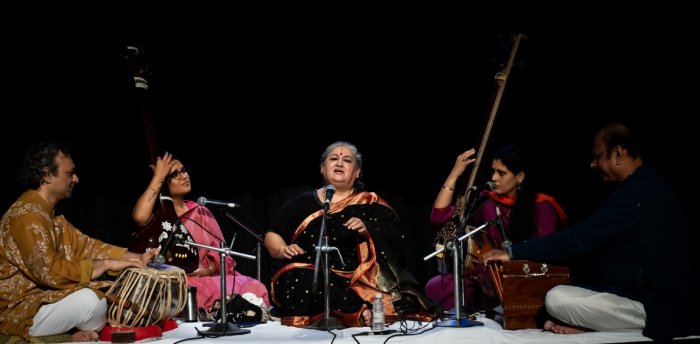 Shubha Mudgal and group While not the main part of this write-up, one needs to mention that the music component in the festival, pertaining to Hindustani classical, gave it an added dimension. Creating a magical atmosphere in the dusk, on the first evening, was Shubha Mudgal's powerful voice rendering Shuddhakalyan with Dr. Aneesh Pradhan on the tabla (which for some inexplicable reason was low in sound), and Sudhir Nayak on the harmonium, followed by Nirakat Shyam in raga Desh and on request the Thumri, Shyam darshan bina neendh na aye in Tilang. 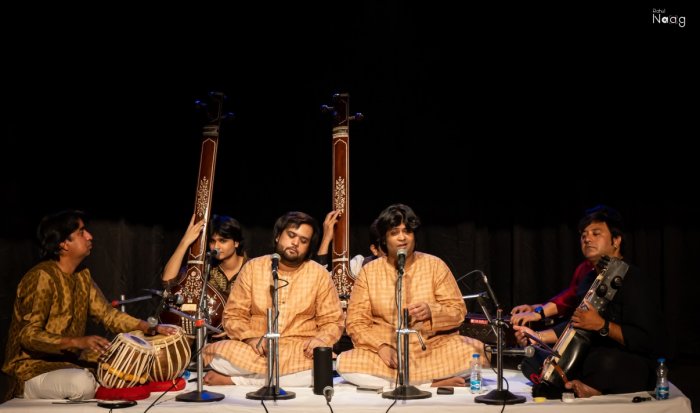 Mehboob Hussain Khan & Fareed Hasan Khan Khayal with the wonderful buildup in raag Yaman rendered by vocalists Fareed Hasan Khan and Mehboob Hussain Khan of Delhi Gharana, had an efflorescence of taans. An educating touch, mentioning the over hundred types of taans their father taught them, a passing demonstration underlined the difference between taans - one like Badal Garaj and the other Bijli Chamki! Along with Akbar Latif Khan's delectable tabla and the sur-filled sarangi of Ahsan Ali, and harmonium of Ashish Kumar, when the last number a bhajan in Pilu - Jinke hridayme Hari nama basey, aur ka naam liya na liya finished, one had the feeling of wanting to hear much more. 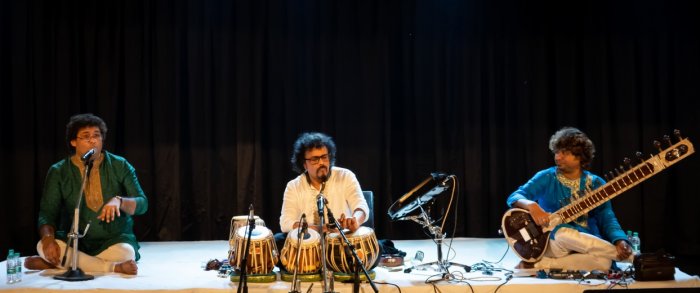 Bickram Ghosh & group Led by Bickram Ghosh, the concluding session of his ensemble Rhythm Scape marked the blend of so many streams of music that fusion delights in. This was the typical contemporary face of music with rhythm of all forms equally happy in competition and in unison. Ragas sported qualities a little different but still pertaining to a particular melodic mode. "We take some liberties" was what was said - as compositions in ragas like Kalawati, Jog (Dance of Shiva), Durga were rendered. With Nirmalya Roy for vocals, Abhishek Sircar on electric guitar, Pulak Sirkar on keyboard, and Arun Kumar whose play on the drums created a buzz, the various rhythm combinations of tisra , chatusra, khanda, misra were all parts of an exciting display. There was nothing in sankeerna though. But it was a rousing end, though the decibel levels, even in the open air, were a little numbing for elderly ear drums! SELF CENTERED DANCE INSTITUTIONS 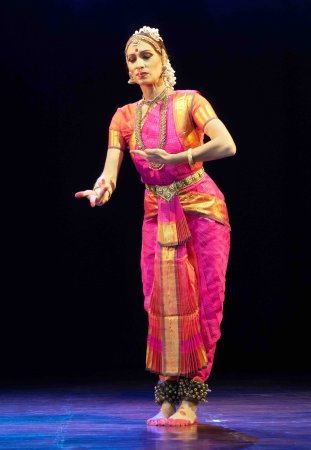 Valerie Kanti Fernando One realizes that institutions run by individual dancers have to contend with steep competition - for room at the top for performance opportunities and recognition is limited. But one would expect a modicum of fellow feeling binding dancers as professional colleagues, for without this, performing art space would be stifling. I am mentioning this aspect because in the recent Bharatanatyam performance in the capital on the occasion of the 78th anniversary of Bharatha Natya Kala Mandir located in Mumbai, with a performance by Valerie Kanti Fernando, disciple of Guru Harikrishna Kalyanasundaram, I was shocked to see about thirty persons seated in the Kamani auditorium! Not a single recognizable face of a Bharatanatyam performer, or of any of the eminent artistes running institutions, did I see. One realizes that artistes 'who have arrived' so to speak, lead very busy lives and to spare time to watch others perform, is not always possible. But surely, goodwill demands that a senior student or students be encouraged to attend as a welcoming gesture - with a word perhaps of regret about not being able to attend personally. The institution celebrating its 78th anniversary is a reputed school in Mumbai, established by sons of Tiruvidaimarudur Kuppiah Pillai (descendent of Venkatakrishna Nattuvanar of King Sarfoji's time), Mahalingam Pillai and Kalyanasundaram, and son-in-law Govindaraja Pillai (son of Subrahmanya Nattuvanar). Sons of Govindaraj Pillai and Mahalingam Pillai, Vasant Kumar and Viswanath have also followed the tradition. So this is a real Parivar Parampara, and irrespective of the dancer performing, one would think that the Bharatanatyam Biradari, if it exists, would acknowledge this historicity by registering their presence. But it would seem that I was wrong. Harikrishna's student, who has always lived in France, is a quietly correct dancer, with very little flash about her. Small built, with a mobile face for abhinaya, her dance (after being informed about a life lived away from India) surprises one with its aura of being at ease with this culture and tradition, though in Padams portraying the khandita nayika like "Tsala maina maata lanta tsalu tsalu ra" set to raga Behag, a much bolder expression of the nayika would have been more effective. But that though muted, facial expressions come naturally was clear from the Usseni Swarajati "E Maayalaadiraa Swami, Nikemani bodinceraa naa saami," wherein the nayika wants to know from the nayak as to what wiles had been worked on him by the other woman for him to capitulate by completely forgetting her faithfulness. The recital was a combination of the very traditional along with new creations of Harikrishna. So one was treated to the usual "Sarasijakshuli jalakamade" Sabdam, along with the new Kavutvam on Lord Rama. 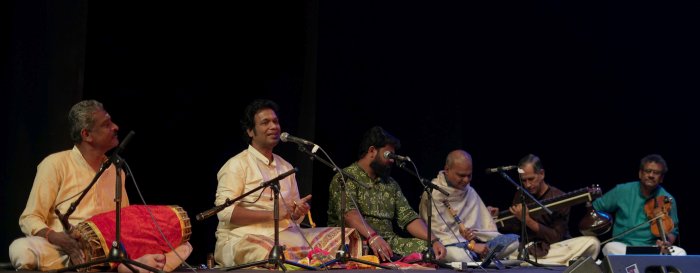 Music ensemble Particularly moving were the purely devotional items like "Yengum Chidambaram, yengum Shivamayam" and the concluding prayer from Tirumoolar. The dancer could have more of the fire of assertion in items like the Tillana, with the guru's cross rhythm patterns. The musical support, which showed the understanding coming from a long tour and frequent performances, comprised artists from Chennai - Diru Nair Venugopal's vocal with Harikrishna's nattuvangam , with Vedakrishna Ram on mridangam, Kalaiarasan on the violin, Mudikondan Ramesh on the veena and G. Raghuraman on flute.  Writing on the dance scene for the last forty years, Leela Venkataraman's incisive comments on performances of all dance forms, participation in dance discussions both in India and abroad, and as a regular contributor to Hindu Friday Review, journals like Sruti and Nartanam, makes her voice respected for its balanced critiquing. She is the author of several books like Indian Classical dance: Tradition in Transition, Classical Dance in India and Indian Classical dance: The Renaissance and Beyond. Post your comments Pl provide your name and email id along with your comment. All appropriate comments posted with name and email id in the blog will also be featured in the site. |